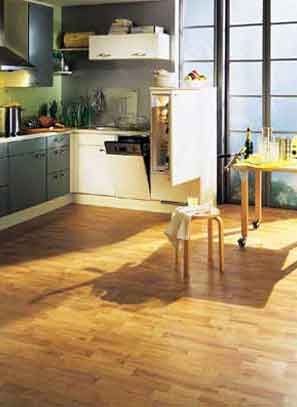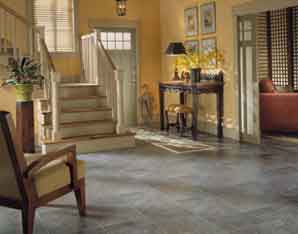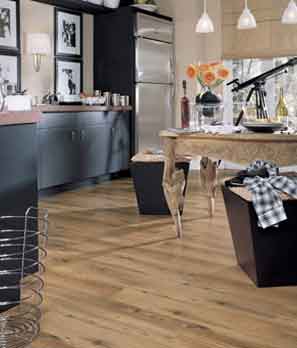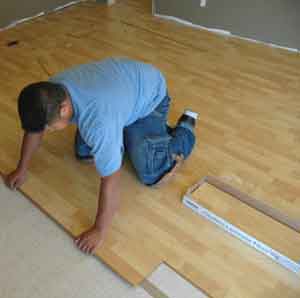Laminate Choices
At home, your style should be looked upon, and walked upon.
It’s personal and individual and wonderful. It’s your sense of what’s “right” design wise, your uncanny ability to know what looks good and works well in your home. It’s your style and you call upon it to make hundreds of decisions.
It goes without saying that you should use that unique sense when choosing something as critical as laminate flooring. Critical? Yes! Because any floor covering in your home impacts interior beauty, design, comfort, livability and upkeep. It’s a fact, floor coverings can make or break a home.
Knowing the basic types of laminate and laminate installation can provide you with a firm foundation upon which to begin your laminate shopping journey.
This section explains laminate flooring types, and offers you the information you need to make smart choices for you and your home.
Fake looking laminates are history.
If laminates looked fake the last time you checked, it’s time to check again!
Today’s laminates are looking better and better, and often need close examination to be identified.
Laminates have truly come a long way. Why?
Because of the growing popularity of laminates, manufacturers are creating an increasing array of traditional, rustic, and exotic wood grain designs.
In fact, presses have improved to the point where the texture imprinted on top of the design looks more real than ever, even with distressed wood or natural stone designs.
Here’s the latest in laminates.
As with sheet vinyl floors, some of the new laminates really have the look of natural materials, particularly the textured products that give the floor dimension.
The most common, basic laminate designs have a wood grain appearance. Some of the most popular laminates have rustic or historic wood grain patterns.
Quality is a snap with multiple photographs.
The quality of the laminate partially has to do with the photography and the number of photographs per style, which is known as "screens".
Here’s an example for you. When manufacturers emulate a natural stone tile, they try to recreate the variation in color, pattern and texture that is a result of cutting a natural product.
The more screens a product has, the more variation it can offer. And the more “authentic” the laminate looks.
Color can make all the difference.
Like any floor, select the laminate color to compliment the size and décor of your room and the activities taking place.
Remember that lighter colors will make a smaller room appear larger, while darker colors will absorb the light and create a more intimate setting.
Choose a color that either coordinates or contrasts with your cabinets and other furniture.
Avoid matching everything to the same color and style. Let your creativity guide you! And remember, contrasts can make your room more interesting.
Laminate flooring types – yours will be installed in one of these 4 forms.
Glueless laminate flooring.
No mess, glueless installation makes these floors quick and easy-to-install. Glueless laminate flooring is the largest segment of all laminate flooring installation today.
They come in a variety of ceramic and wood designs and colorations, as well as some manufacturers offer a real, hardwood veneer instead of a printed layer. It looks amazingly hardwood-like.
These floors come in both planks and tiles. A thin, plastic underlayment is needed to seal out moisture from below. (Remember, moisture is the enemy of your flooring.)
In fact, most laminate floors require a plastic underlay sheet (4 mil poly) be installed directly underneath the laminate planks or tiles.
This helps the floor float freely over the subfloor. Another option is to add a vapor barrier or noise reduction underlay before installing the laminate flooring.
Laminate flooring with attached underlay.
These floors come with several different types of tongue and grooved locking systems and an attached underlayment to reduce noise levels.
Glued laminate flooring.
These are the original laminate floors that do require a special formulated glue to be applied to the tongue and grooved areas for each plank.
Once the glue is dried the planks are almost impossible to pull apart. These floors are offered in both planks and tiles.
Pre-glued laminate flooring.
No mess, because the glue is already applied to the tongue and grooves which makes these floors quick and easy-to-install.
A thin, plastic underlayment is needed to seal out moisture and prevent the glue from sticking to the substrate.
Top off your laminate flooring with moldings.
Laminate moldings also affect the overall style and give your room a beautiful finished look.
Moldings are important because they cover the space that is allowed for the flooring to expand and move naturally on top of the subfloor, and they help with the transition to an adjacent floor.
Most manufacturers offer coordinating moldings for all styles and colors for any laminate flooring you choose. Please note that these moldings are designed to coordinate with your floor and not designed to be an exact match.
Also, be aware that moldings for laminates are slightly larger than their wood or ceramic tile counterparts.
Here, to familiarize you with various standard moldings, are some styles and definitions.
The Step Down Stairnose is a coordinating piece providing the proper transition for all the steps in your home.
A Reducer Strip is the transitional piece our installers use to connect the laminate with another type of floor covering such as vinyl, thin ceramic tile, or low-pile carpeting.
An End Molding or Carpet Reducer is used as a transition from laminate floors to different flooring surfaces when the reducer does not allow enough height, such as on high-pile carpet or thick ceramic tile.
T-Molding is commonly used in doorways to join two laminate floors inadjoining rooms. It's also recommended when making transitions from a laminate floor to another floor that is approximately the same height.
Finally, a Quarter Round may be installed wherever the laminate floor meets the wall or baseboard.
We recommend that you work closely with us to become familiar with the moldings and transition pieces.
Ask to see samples if possible, so there are no surprises come installation time.
Those are the basics regarding laminate flooring types.
We hope this helps sharpen your focus on a laminate style to match the pattern of life in your home.




